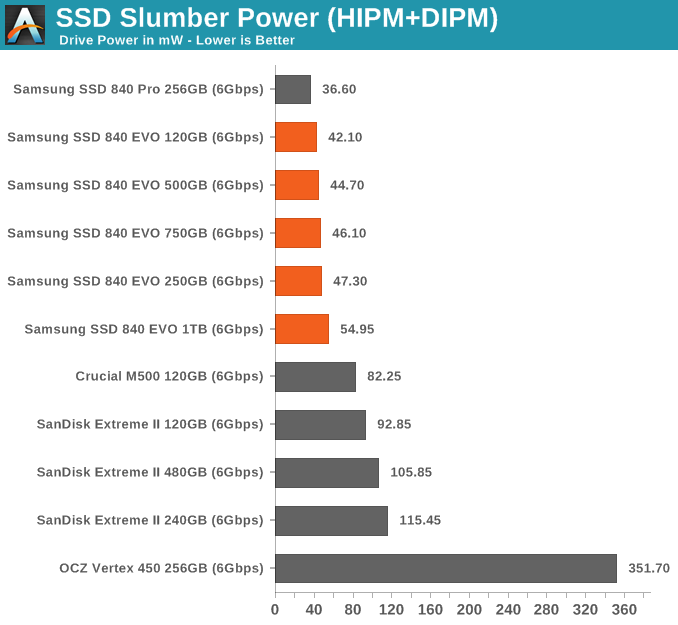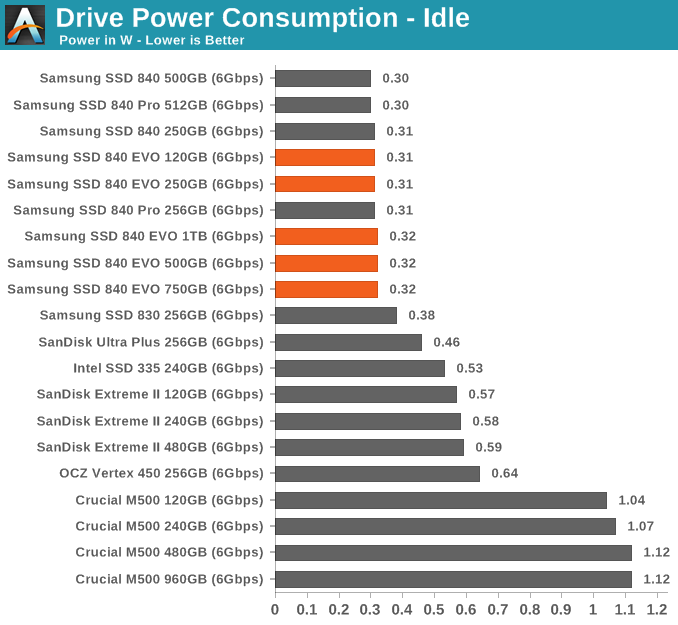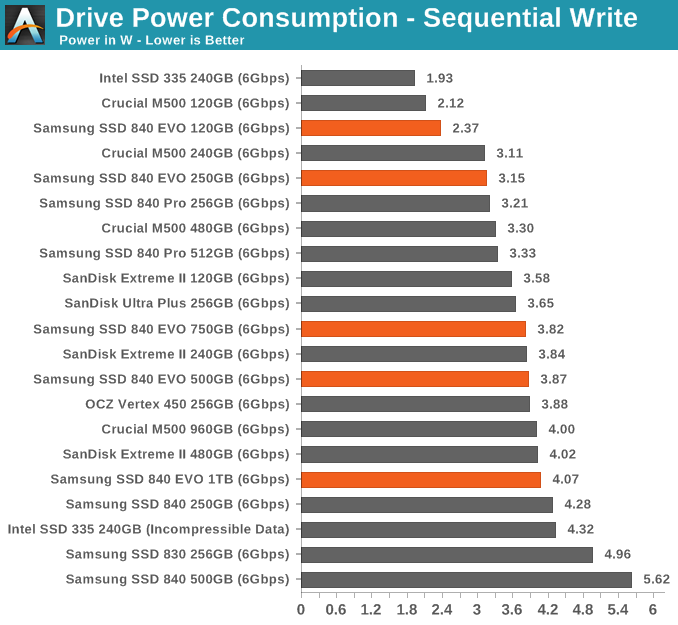Samsung SSD 840 EVO Review: 120GB, 250GB, 500GB, 750GB & 1TB Models Tested
by Anand Lal Shimpi on July 25, 2013 1:53 PM EST- Posted in
- Storage
- SSDs
- Samsung
- TLC
- Samsung SSD 840
Power Consumption
Low power consumption has always been a staple of Samsung's SSDs, and the EVO is no different. Idle and load power are among the best here. I'm also expanding our DIPM testing, first introduced in the SanDisk Extreme II review:
We're introducing a new part of our power consumption testing with this review: measurement of slumber power with host initiated power management (HIPM) and device initiated power management (DIPM) enabled. It turns out that on Intel desktop platforms, even with HIPM and DIPM enabled, SSDs will never go into their lowest power states. In order to get DIPM working, it seems that you need to be on a mobile chipset platform. I modified an ASUS Zenbook UX32VD to allow me to drive power to the drive bay from an external power supply/power measurement rig. I then made sure HIPM+DIPM were enabled, and measured average power with the drive in an idle state. The results are below:

The EVO is almost as good as the Pro from a slumber power perspective, and significantly better than anything else in the list here.













137 Comments
View All Comments
Grim0013 - Sunday, July 28, 2013 - link
I wonder what, if anything, the impact of Turbo Write is on drive endurance, as in, does the SLC buffer have the effect of "shielding" the TLC from some amount of write amplification (WA)? More specifically, I was thinking that in the case of small random writes (high WA), many of them would be going to the SLC first, then when the data is transferred to the TLC, I wonder if the buffering affords the controller the opportunity to write the data is such a way as to reduce WA on the TLC?In fact, I wonder if that is something that is done...if the controller is able to characterize certain types of files as being likely the be frequently modified then just keep them in the SLC semi-permanently. Stuff like the page file and other OS stuff that is constantly modified...I'm not very well-versed on this stuff so I'm just guessing. It just seems like taking advantage of SLCs crazy p/e endurance in addition to it's speed could really help make these things bulletproof.
shodanshok - Sunday, July 28, 2013 - link
Yea, I was thinking the same thing. After all, Sandisk already did it on the Ultra Plus and Ultra II SSDs: they have a small pseudo-SLC zone used both for greater performance and reducing WA.shodanshok - Sunday, July 28, 2013 - link
I am not so exited about RAPID: data integrity is a delicate thing, so I am not so happy to trust Samsung (or others) replacing the key well-tested caching algorithm natively built into the OS.Anyway, Windows' write caching is not so quick because the OS, by default, flush its in-memory cache each second. Moreover, it normally issue a barrier event to flush the disk's DRAM cache. This last thing can be disabled, but the flush of the in-memory cache can not be changed, as far I know.
Linux, on the other side, use much aggressive caching policy: it issue an in-memory cache flush (pagecache) ever 30 seconds, and it aggressively try to coalesce multiple writes into a single transactions. This parameter is configurable using the /proc interface. Moreover, if you have a BBU or power-tolerant disk subsystem, you can even disable the barrier instruction normally issued to the disk's DRAM cache.
Timur Born - Sunday, July 28, 2013 - link
My Windows 8 setup uses quite exactly 1 gb RAM for write caching, regardless of whether it's writing to a 5400 rpm 2.5" HD, 5400 rpm 3.5" HD or Crucial M4 256 gb SSD. That's exactly the size of the RAPID cache. The "flush its cache each second" part becomes a problem when the source and destination are on the same drive, because once Windows starts writing the disk queue starts to climb.But even then it should mostly be a problem for spinning HDs that don't really like higher queue numbers. Even more so when you copy multiple files via Windows Explorer, which reads and write files concurrently even on spinning HDs.
So I wonder if RAPID's only real advantage is its feature to coalesce multiple small writes into single big ones for durations longer than one second?!
Timur Born - Sunday, July 28, 2013 - link
By the way, my personal experience is that CPU power saving features, as set up in both in the default "Balanced" and the "High Performance" power-profiles, have far more of an impact on SSD performance than caching stuff. I can up my M4' 4K random performance by 60% and more just by messing with CPU power savings to be less aggressive (or off).shodanshok - Monday, July 29, 2013 - link
If I correctly remember, Windows use at most 1/8 of total RAM size for write caching. How much RAM did you have?Timur Born - Tuesday, July 30, 2013 - link
8 gb, so you may be correct. Or you may mix it up with the 1/8 part of dirty cache that is being flushed by the Windows cache every second. Or both may be 1/8. ;-)zzz777 - Monday, July 29, 2013 - link
I'm interested in caching writes to a ram disk then to storage. This reminds me if the concept of a write-back cache: for almost everyone The possibility of data corruption is so low that there's no reason not to enable it: can this ssd ramdisk write quickly enough that home users also don't have to worry about using it? Beyond that I'm not a normal home user, I want to see benchmarks for virtualization, I want the quickest way to create, modify and test a vm before putting it on front life hardwareWwhat - Monday, July 29, 2013 - link
I for me still say: I rather go for the pro version.andreaciri - Thursday, August 1, 2013 - link
i have to decide if buy an 840 now, or an EVO when it will be available, for my macbook. considering that RAPID technology is only supported under windows, and that i'm more interested in read performance than write, is 840 a good choice?